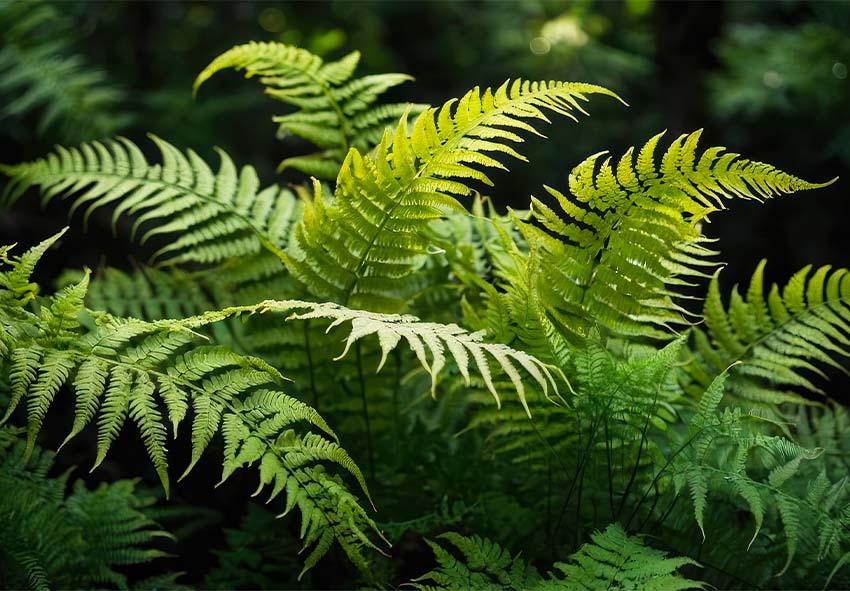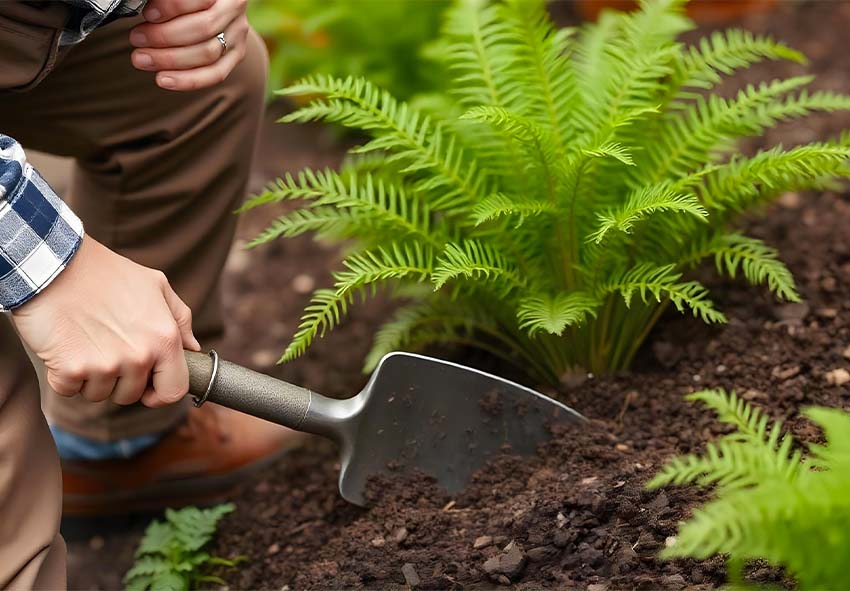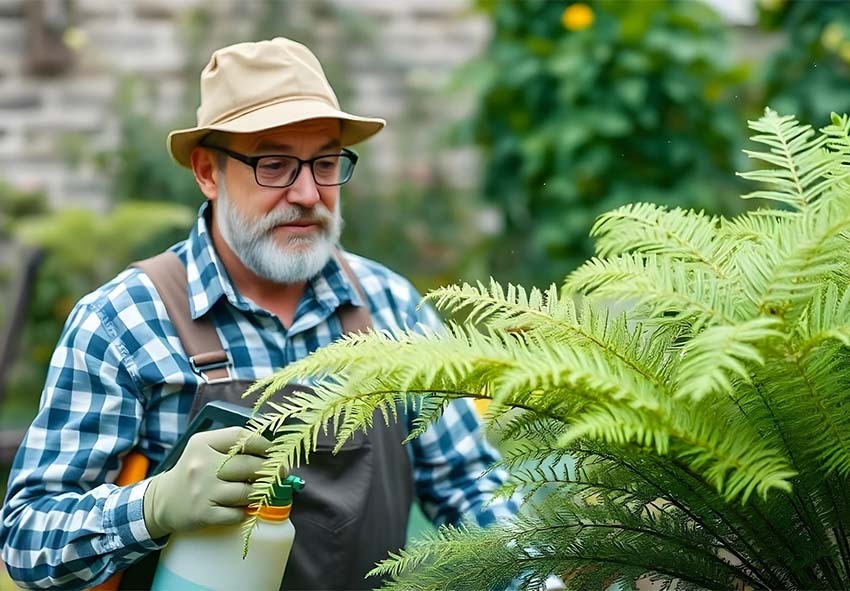Ferns are among the most beloved plants for both indoor and outdoor gardening enthusiasts. With their lush, delicate fronds and ability to thrive in low-light conditions, ferns add a touch of greenery and tranquility to any space. However, to keep these beautiful plants healthy and thriving, it’s essential to understand the basics of fern care.
Whether you’re a seasoned gardener or a beginner, this comprehensive guide will walk you through everything you need to know about ferns—from choosing the right varieties for your space to planting, caring for, and even propagating these elegant plants. Our gardening blog is a perfect place to find all the information you need!
Understanding Ferns

Ferns are a diverse group of plants known for their feathery, divided leaves called fronds. They are among the oldest types of plants on Earth, dating back millions of years. Unlike flowering plants, ferns reproduce through spores rather than seeds, which is one of their most distinctive characteristics.
What Are Ferns?
Ferns belong to a group of vascular plants that reproduce via spores and have neither seeds nor flowers. They typically thrive in shady, moist environments, making them ideal for indoor settings and shaded garden areas. There are thousands of fern species worldwide, with various sizes, shapes, and colors, providing plenty of options for every gardener.
Some common fern varieties found in homes and gardens include the Boston Fern, known for its arching fronds, and the Maidenhair Fern, which is prized for its delicate, lace-like foliage.
Benefits of Growing Ferns
Growing ferns offers several benefits beyond their visual appeal and other advantages:
| Benefit | Description |
| Flowering Period | Ferns do not produce flowers; their appeal comes from their lush, evergreen fronds. |
| Fragrance | Ferns are generally non-fragrant, focusing on their visual beauty rather than scent. |
| Height | Ferns vary in height, from low-growing ground covers to tall, dramatic varieties, typically ranging from 6 inches to 6 feet. |
| Climate | Ferns are adaptable to various climates; indoor ferns thrive in moderate temperatures, while outdoor ferns generally prefer shaded, humid environments. |
| Air Cleaning | Ferns are excellent at improving indoor air quality by filtering out toxins and increasing humidity. |
| Maintenance | Ferns are low-maintenance plants, requiring minimal pruning and care compared to many other types of houseplants. |
Choosing the Right Ferns for Your Space

Selecting the right fern variety for your indoor or outdoor space is crucial for ensuring healthy growth and longevity. With so many varieties available, it’s important to consider factors like light, humidity, and temperature.
Popular Indoor Fern Varieties
Indoor ferns are particularly popular due to their ability to thrive in lower light conditions. Some of the most popular indoor ferns include:
- Boston Fern: This classic fern is known for its long, arching fronds and is perfect for hanging baskets or pots.
- Maidenhair Fern: Delicate and elegant, the Maidenhair Fern requires consistent moisture and is best suited for bathrooms or humid environments.
- Bird’s Nest Fern: With its unique, wavy fronds, this fern adds a modern touch to any indoor space and is relatively low maintenance.
Best Outdoor Ferns for Your Garden
When it comes to outdoor planting, it’s a good decision to add ferns in garden design. There are varieties that thrive in shaded garden areas, adding texture and greenery to your landscape:
- Ostrich Fern: Known for its tall, feather-like fronds, the Ostrich Fern is ideal for shaded garden beds.
- Japanese Painted Fern: This fern is admired for its silvery fronds with purple veins, making it a striking addition to any garden.
- Lady Fern: A hardy choice, the Lady Fern is adaptable to various soil conditions and adds a delicate touch to garden borders.
How to Select Healthy Ferns at the Nursery
When purchasing ferns, it’s important to choose healthy plants to ensure successful growth. Look for ferns with vibrant, green fronds and avoid any with yellowing or brown edges, as these may indicate poor health. Check the roots to ensure they are firm and white, not mushy or black. Selecting healthy ferns at the start will set you up for success in your gardening journey.
Planting Ferns

Proper planting is essential for the healthy growth of ferns, whether you’re planting them indoors in pots or outdoors in your garden. Understanding the best time to plant and how to prepare the soil can make a significant difference in their growth and longevity.
Best Time to Plant Ferns
The best time to plant ferns largely depends on your climate. In cooler regions, it’s ideal to plant ferns in the spring when the soil is warm, giving them time to establish roots before the colder months. In warmer climates, fall can also be a good time for planting, allowing ferns to settle in during the cooler season before the heat of summer.
Preparing the Soil for Ferns
Ferns thrive in soil that is rich in organic matter and has good drainage. Before planting, it’s essential to amend the soil with compost or peat moss to improve its texture and nutrient content. Ferns prefer slightly acidic to neutral soil, with a pH between 6.0 and 7.0. Testing your soil’s pH and making adjustments as needed will help create the optimal environment for your ferns to flourish.
Planting Ferns in the Ground
Here are some tips for planting your ferns:
- Digging the Hole: Dig a hole that is twice as wide as the fern’s root ball but no deeper than the height of the root ball. Ensure the hole is the right depth to accommodate the fern at its current root level.
- Placing the Fern: Position the fern in the center of the hole, ensuring it is planted at the same depth it was growing in its container or previous location. Keep the fern upright and avoid disturbing the roots as you place it in the hole.
- Backfilling with Soil: Gently backfill the hole with the excavated soil, mixing in some compost if needed to improve soil quality.bLightly firm the soil around the root ball to eliminate air pockets and ensure good soil-to-root contact.
- Watering: Water the newly planted fern thoroughly to settle the soil and help the fern establish its roots.
How to Plant Ferns in Pots
Planting ferns in pots is a great way to bring greenery indoors or add flexibility to your garden design. Start by choosing a pot with adequate drainage holes to prevent water from sitting at the bottom, which can cause root rot. Fill the pot with a well-draining potting mix, place the fern in the center, and gently firm the soil around the roots. Water thoroughly after planting to help the fern settle into its new home.
Caring for Your Ferns

Proper care is crucial for maintaining the health and beauty of your ferns. This involves regular watering, ensuring the right light conditions, and occasionally fertilizing to keep your ferns thriving.
Watering Requirements
Ferns require consistent moisture, but it’s important to avoid overwatering, which can lead to root rot. For indoor ferns, water when the top inch of soil feels dry, and be sure to drain any excess water from the saucer. Outdoor ferns may need more frequent watering during hot, dry periods. Watch for signs of overwatering, such as yellowing fronds, and adjust your watering schedule accordingly.
Light and Temperature Needs
Understanding the light and temperature requirements of ferns is crucial for their healthy growth, as these factors significantly influence their overall well-being and development:
1. Light Conditions
- Indoor Ferns: Prefer indirect light or low light. Avoid direct sunlight as it can scorch the fronds.
- Outdoor Ferns: Thrive in shaded or partially shaded areas. Ideal for under trees or on the north side of buildings.
2. Temperature Requirements
- Indoor Ferns: Prefer temperatures between 60-75°F (16-24°C). Avoid sudden temperature changes and cold drafts.
- Outdoor Ferns: Generally thrive in moderate climates. Protect from extreme temperatures and ensure adequate winter protection in colder regions.
3. Humidity Levels
- Indoor Ferns: Benefit from high humidity. Use a humidifier or place the fern on a humidity tray if indoor air is dry.
- Outdoor Ferns: Usually adapt well to natural outdoor humidity levels. Ensure the planting area is consistently moist.
Fertilizing Ferns
Ferns don’t require heavy feeding, but occasional fertilizing can support their growth, especially during the growing season. Use a balanced, water-soluble fertilizer diluted to half strength every 4-6 weeks during spring and summer. Avoid over-fertilizing, as this can cause salt buildup in the soil, leading to browning fronds.
Pruning and Maintenance
Regular pruning helps keep your ferns looking their best by removing dead or damaged fronds. Use sharp scissors or pruning shears to trim away any yellow or brown fronds at the base. Additionally, keeping your ferns clean by dusting or rinsing off their fronds occasionally will help them photosynthesize more efficiently and maintain their vibrant appearance.
Common Problems and Solutions

Even with the best care, ferns can encounter problems such as pests, diseases, or environmental stress. Being able to identify and address these issues quickly will help you keep your ferns healthy.
Pests That Affect Ferns
Ferns can be susceptible to pests such as aphids, mealybugs, and spider mites. Regularly inspecting your ferns and treating infestations early with insecticidal soap or neem oil can prevent pests from spreading. It’s also important to maintain good air circulation around your ferns to reduce the likelihood of pest problems.
Diseases in Ferns
Ferns can be affected by fungal diseases like root rot, especially if they are overwatered or planted in poorly draining soil. Yellowing fronds or a musty smell from the soil can indicate root rot. To treat this, reduce watering, improve drainage, and remove any affected fronds or roots. Using a fungicide may also be necessary in severe cases.
Troubleshooting Common Issues
Yellowing fronds, wilting, or browning edges are common issues that can arise with ferns. These symptoms often indicate environmental stress, such as incorrect watering, lighting, or humidity. Adjusting your care routine to meet the specific needs of your fern can help resolve these issues. For example, increasing humidity with a humidifier or misting can help ferns that are drying out, while adjusting the light exposure can prevent further frond damage.
Propagating Ferns
Propagating ferns allows you to expand your collection or share your plants with others. There are a few methods to propagate ferns, each with its own advantages.
Methods of Propagation

Ferns can be propagated by spores or division. But there’s actually more methods of propagation for ferns:
1. Spores: Ferns reproduce naturally through spores, which are tiny, dust-like particles that develop on the underside of mature fronds.
Process:
- Collection: Harvest mature spores from the underside of fronds once they turn brown and are ready to release.
- Sowing: Spread the spores evenly on a sterile growing medium, such as a mix of peat and sand.
- Germination: Keep the medium consistently moist and in a humid environment. Cover with plastic wrap or a humidity dome to maintain moisture.
- Care: Once spores germinate and small fernlets (prothalli) appear, remove the cover and continue to provide humidity and light until the ferns are large enough to transplant.
2. Division: This method involves dividing a mature fern into smaller sections, each of which can grow into a new plant.
Process:
- Timing: Best done in spring or early fall when the fern is actively growing.
- Separation: Gently remove the fern from its pot or garden bed. Carefully separate the root ball into smaller sections, ensuring each section has a healthy root system.
- Replanting: Plant each division in a new pot or garden bed at the same depth it was previously growing. Water thoroughly and provide appropriate care.
3. Offsets: Some ferns produce offsets or “pups” around their base, which can be separated and planted individually.
Process:
- Identification: Look for small, new ferns growing around the base of the parent plant.
- Separation: Gently detach the offsets from the main plant, making sure they have their own roots.
- Planting: Place the offsets in new pots or garden beds, and water well to help them establish.
4. Root Cuttings: This method involves taking sections of the fern’s roots and encouraging them to develop into new plants.
Process:
- Timing: Best performed in early spring or late fall.
- Harvesting: Dig up the fern and cut healthy root sections from the main root system.
- Planting: Plant the root cuttings in pots or garden beds with a well-draining growing medium. Water well and maintain consistent moisture until new growth appears.
Each of these propagation methods offers a way to grow new ferns from existing plants, allowing you to expand your collection or share ferns with others. Choose the method that best suits your fern species and gardening preferences.
Conclusion
Ferns, with their graceful fronds and varied forms, are an excellent choice for both novice and experienced gardeners. By understanding the unique needs of ferns and applying the care tips provided, you can successfully cultivate these lush plants in any environment. Whether you’re adding a Boston Fern to your indoor space or incorporating the Japanese Painted Fern into your garden landscape, ferns can bring a touch of elegance and tranquility.
Don’t be discouraged if you encounter challenges along the way; with a little patience and knowledge, you can overcome common issues and enjoy the rewards of a thriving fern collection. For further assistance, our online plant store offers a wide range of ferns, along with expert advice and resources to support your gardening endeavors.
Frequently Asked Questions (FAQs) about Ferns
1. What is the best location to place ferns indoors?
The best location for indoor ferns is in a spot with indirect light, such as near a north or east-facing window. Avoid direct sunlight, as it can scorch the fronds, and ensure the area has good air circulation.
2. Can I order fern plants from your online store?
We are pleased to offer a variety of ferns for sale. Our selection includes different ferns cultivars, each with its unique foliage and characteristics. You can browse our online store Dutch-bulbs.com to explore the options, and order your plants with a few clicks.
3. Can ferns be grown outdoors in cold climates?
Some ferns are hardy and can tolerate cold climates, especially if they are protected during the winter. It’s important to choose fern species that are suited to your climate and provide mulch or other protective measures during harsh winters.
4. How do I prevent my fern’s fronds from turning yellow?
Yellowing fronds can be a sign of overwatering, underwatering, or low humidity. Ensure your fern is receiving the right amount of water and consider misting the fronds or using a humidity tray if indoor air is dry. Proper light levels are also crucial to prevent yellowing.
5. What is the easiest method to propagate ferns?
The easiest method to propagate ferns is through division. This involves carefully separating a mature fern into smaller sections, each with its own roots, and replanting them. This method is straightforward and typically has a high success rate.
Published: 03.09.2024
